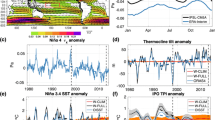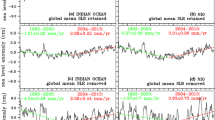Abstract
Three prominent features of ocean surface turbulent heat fluxes (THF) trends during 1958–2013 are identified based on the Objectively Analyzed air-sea Fluxes (OAFlux) data set. The associated ocean-atmosphere dynamics changes are further investigated based on the National Centers for Environmental Prediction/National Center for Atmospheric Research (NCEP/NCAR) reanalysis. First, the THF are enhanced over the mid-latitude expansions of the subtropical western boundary currents (WBCs). An intensified oceanic heat transport, forced by stronger near-surface zonal wind, is likely to be the cause of such THF tendency. Second, the THF are reduced over the tropical eastern Pacific Ocean, which is primarily caused by the decreasing near-surface wind speed and sea surface temperature (SST), associated with a local coupled ocean-atmosphere cooling mode. Finally, the THF are reduced over the northern tropical Atlantic Ocean, which is attributed to the decreasing air-sea humidity and temperature differences as a result of the convergence of near-surface air and the divergence of ocean currents (upwelling).








Similar content being viewed by others
References
Andersson A, Fennig K, Klepp C, Bakan S, Graßl H, Schulz J (2010) The Hamburg Ocean Atmosphere Parameters and Fluxes from Satellite Data-HOAPS-3. Earth System Science Data Discussions 3:143–194
Bourassa MA, Gille ST, Bitz C, Carlson D, Cerovecki I, Clayson CA, Cronin MF, Drennan WM, Fairall CW, Hoffman RN et al (2013) High-latitude ocean and sea ice surface fluxes: challenges for climate research. Bull Am Meteorol Soc 94(3):403–423
Brunke MA, Wang Z, Zeng X, Bosilovich M, Shie CL (2011) An assessment of the uncertainties in ocean surface turbulent fluxes in 11 reanalysis, satellite-derived, and combined global datasets. J Clim 24(21):5469–5493
Cai W, Shi G, Cowan T, Bi D, Ribbe J (2005) The response of the Southern Annular Mode, the East Australian Current, and the southern mid-latitude ocean circulation to global warming. Geophys Res Lett 32 (23):L23,706
Cane M, Clement A, Kaplan A, Kushnir Y, Pozdnyakov D, Seager R, Zebiak S, Murtugudde R (1997) Twentieth-century sea surface temperature trends. Science 275(5302):957–960
Cayan DR (1992) Latent and sensible heat flux anomalies over the northern oceans: driving the sea surface temperature. J Phys Oceanogr 22(8):859–881
Chou SH, Nelkin E, Ardizzone J, Atlas RM, Shie CL (2003) Surface turbulent heat and momentum fluxes over global oceans based on the Goddard satellite retrievals, version 2 (GSSTF2). J Clim 16(20):3256–3273
Chou SH, Nelkin E, Ardizzone J, Atlas RM (2004) A comparison of latent heat fluxes over global oceans for four flux products. J Clim 17(20):3973–3989
Clayson CA, Bogdanoff AS (2013) The effect of diurnal sea surface temperature warming on climatological air–sea fluxes. J Clim 26(8):2546–2556
Curry J, Bentamy A, Bourassa M, Bourras D, Bradley EF, Brunke M, Castro S, Chou S, Clayson C, Emery W et al (2004) Seaflux. Bull Am Meteorol Soc 85(3):409–424
Curry RG, McCartney MS (2001) Ocean gyre circulation changes associated with the North Atlantic Oscillation. J Phys Oceanogr 31(12):3374–3400
Da Silva A, Young C, Levitus S (1994) Atlas of surface marine data 1994, vol. 1, Algorithms and Procedures, NOAA Atlas NESDIS 6. US Dep of Commer, Washington, DC
Deser C, Alexander M, Timlin M (1999) Evidence for a wind-driven intensification of the Kuroshio Current Extension from the 1970s to the 1980s. J Clim 12(6):1697–1706
DiNezio PN, Gramer LJ, Johns WE, Meinen CS, Baringer MO (2009) Observed interannual variability of the Florida Current: Wind forcing and the North Atlantic Oscillation. J Phys Oceanogr 39(3):721–736
Fairall C, Bradley EF, Hare J, Grachev A, Edson J (2003) Bulk parameterization of air-sea fluxes: updates and verification for the COARE algorithm. J Clim 16(4):571–591
Frankignoul C, Kestenare E (2002) The surface heat flux feedback. Part I: estimates from observations in the Atlantic and the North Pacific. Clim Dyn 19(8):633–647. doi:10.1007/s00382-002-0252-x
Gao S, Chiu LS, Shie CL (2013) Trends and variations of ocean surface latent heat flux: Results from GSSTF2c data set. Geophysical Research Letters
Gulev S, Jung T, Ruprecht E (2007a) Estimation of the impact of sampling errors in the VOS observations on air-sea fluxes. Part I: uncertainties in climate means. J Clim 20(2):279–301
Gulev S, Jung T, Ruprecht E (2007b) Estimation of the impact of sampling errors in the VOS observations on air-sea fluxes. Part II: impact on trends and interannual variability. J Clim 20(2):302–315
Gulev SK, Belyaev K (2012) Probability distribution characteristics for surface air-sea turbulent heat fluxes over the global ocean. J Clim 25(1):184–206
Gulev SK, Latif M, Keenlyside N, Park W, Koltermann KP (2013) North Atlantic Ocean control on surface heat flux on multidecadal timescales. Nature 499:464–467
Iwasaki S, Kubota M (2011) Increasing trends for the surface heat flux and fresh water flux in the North Pacific eastern subtropical region. Geophys Res Lett 38(10):L10,604
Kalnay E, Kanamitsu M, Kistler R, Collins W, Deaven D, Gandin L, Iredell M, Saha S, White G, Woollen J et al (1996) The NCEP/NCAR 40-year reanalysis project. Bull Am Meteorol Soc 77 (3):437–471
Kelly KA, Small RJ, Samelson R, Qiu B, Joyce TM, Kwon YO, Cronin MF (2010) Western boundary currents and frontal air-sea interaction: Gulf Stream and Kuroshio Extension. J Clim 23(21):5644–5667. doi:10.1175/2010JCLI3346.1
Kosaka Y, Xie SP (2013) Recent global-warming hiatus tied to equatorial Pacific surface cooling. Nature 501(7467):403– 407
Kubota M, Iwasaka N, Kizu S, Konda M, Kutsuwada K (2002) Japanese ocean flux data sets with use of remote sensing observations (J-OFURO). J Oceanogr 58(1):213–225
Liu J, Curry J (2006) Variability of the tropical and subtropical ocean surface latent heat flux during 1989–2000. Geophys Res Lett 33:L05,706
Liu J, Curry JA, Clayson CA, Bourassa MA (2011) High-resolution satellite surface latent heat fluxes in North Atlantic hurricanes. Mon Weather Rev 139(9):2735–2747
Liu WT, Katsaros KB, Businger JA (1979) Bulk parameterization of air-sea exchanges of heat and water vapor including the molecular constraints at the interface. J Atmos Sci 36(9):1722–1735
Marshall GJ (2003) Trends in the Southern Annular Mode from observations and reanalyses. J Clim 16 (24):4134–4143
Meehl GA, Arblaster JM, Fasullo JT, Hu A, Trenberth KE (2011) Model-based evidence of deep-ocean heat uptake during surface-temperature hiatus periods. Nat Clim Chang 1(7):360–364
Minobe S, Kuwano-Yoshida A, Komori N, Xie SP, Small RJ (2008) Influence of the Gulf Stream on the troposphere. Nature 452(7184):206–209
Moore G, Renfrew I (2002) An assessment of the surface turbulent heat fluxes from the NCEP-NCAR reanalysis over the western boundary currents. J Clim 15(15):2020–2037
Qiu B, Chen S (2006) Decadal variability in the large-scale sea surface height field of the South Pacific Ocean: observations and causes. Journal of physical oceanography 36(9):1751–1762
Qiu B, Joyce TM (1992) Interannual variability in the mid-and low-latitude western North Pacific. J Phys Oceanogr 22(9):1062–1079
Ridgway K (2007) Long-term trend and decadal variability of the southward penetration of the East Australian Current. Geophys Res Lett 34(13)
Ridgway K, Coleman R, Bailey R, Sutton P (2008) Decadal variability of East Australian Current transport inferred from repeated high-density XBT transects, a CTD survey and satellite altimetry. J Geophys Res Oceans (1978–2012) 113(C8)
Roemmich D, Gilson J, Davis R, Sutton P, Wijffels S, Riser S (2007) Decadal spinup of the South Pacific subtropical gyre. J Phys Oceanogr 37(2):162–173
Sakamoto TT, Hasumi H, Ishii M, Emori S, Suzuki T, Nishimura T, Sumi A (2005) Responses of the Kuroshio and the Kuroshio Extension to global warming in a high-resolution climate model. Geophys Res Lett 32(14)
Santorelli A, Pinker R, Bentamy A, Katsaros K, Drennan W, Mestas-Nuñez A, Carton J (2011) Differences between two estimates of air-sea turbulent heat fluxes over the Atlantic Ocean. J Geophys Res Oceans (1978–2012) 116(C9)
Sato Y, Yukimoto S, Tsujino H, Ishizaki H, Noda A (2006) Response of North Pacific ocean circulation in a Kuroshio-resolving ocean model to an Arctic Oscillation (AO)-like change in northern hemisphere atmospheric circulation due to greenhouse-gas forcing. J Meteorol Soc Jpn 84(2):295–309
Shaman J, Samelson R, Skyllingstad E (2010) Air-sea fluxes over the Gulf Stream region: atmospheric controls and trends. J Clim 23(10):2651–2670
Tanimoto Y, Nakamura H, Kagimoto T, Yamane S (2003) An active role of extratropical sea surface temperature anomalies in determining anomalous turbulent heat flux. J. Geophys. Res 108(c10):3304. doi:10.1029/2002JC001750
Thompson DW, Wallace JM (2000) Annular modes in the extratropical circulation. Part I: month-to-month variability. J Clim 13(5):1000–1016
Tomita H, Kubota M (2005) Increase in turbulent heat flux during the 1990s over the Kuroshio/Oyashio extension region. Geophys Res Lett 32(9):L09,705
Uppala SM, Kållberg P, Simmons A, Andrae U, Bechtold V, Fiorino M, Gibson J, Haseler J, Hernandez A, Kelly G et al (2005) The ERA-40 re-analysis. Q J R Meteorol Soc 131(612):2961–3012
Woodruff SD, Worley SJ, Lubker SJ, Ji Z, Eric Freeman J, Berry DI, Brohan P, Kent EC, Reynolds RW, Smith SR et al (2011) ICOADS Release 2.5: extensions and enhancements to the surface marine meteorological archive. Int J Climatol 31(7):951–967
Wu L, Cai W, Zhang L, Nakamura H, Timmermann A, Joyce T, McPhaden MJ, Alexander M, Qiu B, Visbeck M et al (2012) Enhanced warming over the global subtropical western boundary currents. Nat Clim Chang 2(3):161–166
Yu L, Weller RA (2007) Objectively analyzed air–sea heat fluxes for the global ice-free oceans (1981–2005). Bull Am Meteorol Soc 88(4)
Yu L, Jin X, Weller RA (2008) Multidecade global flux datasets from the Objectively Analyzed Air-sea Fluxes (OAFlux) project: latent and sensible heat fluxes, ocean evaporation, and related surface meteorological variables. Tech. rep., OAFlux Project Tech. Rep. OA-2008-01
Zeng X, Zhao M, Dickinson RE (1998) Intercomparison of bulk aerodynamic algorithms for the computation of sea surface fluxes using TOGA COARE and TAO data. J Clim 11(10): 2628–2644
Zhang GJ, Mcphaden MJ (1995) The relationship between sea surface temperature and latent heat flux in the equatorial Pacific. J Clim 8(3):589–605
Zhang L, Wu L, Lin X, Wu D (2010a) Modes and mechanisms of sea surface temperature low-frequency variations over the coastal China seas. J Geophys Res 115(C8):C08,031
Zhang W, Li J, Zhao X (2010b) Sea surface temperature cooling mode in the Pacific cold tongue. J Geophys Res Oceans (1978–2012) 115(C12)
Acknowledgments
We would like to thank Wei Wei, Mihai Dima, and Xun Gong for their helpful discussions, and Stefanie Klebe for her friendly review. Jiping Liu is supported by the NOAA Climate Observations and Monitoring Program (NA14OAR4310216) and NASA NEWS. The co-author Chen Xueen’s position is also supported by Taishan scholars program.
Author information
Authors and Affiliations
Corresponding author
Additional information
Responsible Editor: Richard John Greatbatch
Rights and permissions
About this article
Cite this article
Yang, H., Liu, J., Lohmann, G. et al. Ocean-atmosphere dynamics changes associated with prominent ocean surface turbulent heat fluxes trends during 1958–2013. Ocean Dynamics 66, 353–365 (2016). https://doi.org/10.1007/s10236-016-0925-3
Received:
Accepted:
Published:
Issue Date:
DOI: https://doi.org/10.1007/s10236-016-0925-3




